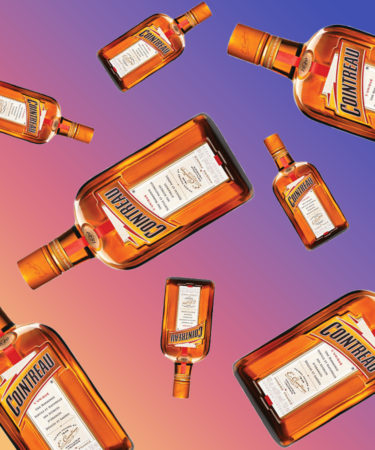Cointreau is a name well known to bartenders and cocktail connoisseurs alike. The triple sec brand has been around since the mid-1800s and has made a name for itself as a versatile cocktail ingredient, used in some of the world’s oldest and best-known libations. Thus, with its trademark square bottle, this French liqueur has become a staple around the world — from Europe to Asia to the Americas.
Although you may already know and love Cointreau, there’s plenty more to discover about the orange liqueur. Read on for 10 more things you should know about Cointreau.
Cointreau invented an entire category of liqueur.
Cointreau uses three types of orange in its liqueur: sweet, macerated, and bitter. Edouard Cointreau decided to call the concoction “triple sec,” a reference to the triple concentration of orange flavors in the liqueur, as well as the dryness of the spirit (“sec” means “dry” in French).
These days, however, with a multitude of triple sec brands on the market, the company has stopped marketing Cointreau as triple sec in the hopes of distinguishing itself from similar products.
Though it’s loved worldwide, it only has one distillery.
Though the orange liqueur is sold in 150 countries each year, all Cointreau is produced at a single distillery: Carré Cointreau in Angers, France. Here, visitors can tour the facility, take part in cocktail classes, and more.
Cointreau combined with another French brand.
In 1989, Cointreau merged with Rémy Martin, a French brand known for producing Cognac. The deal was signed in Carré Cointreau, Cointreau’s distillery. Together, the two brands form Rémy Cointreau.
Cointreau now offers two key products: Cointreau L’Unique and Cointreau Noir. The latter product is an homage to Rémy Martin, marrying the flavors of orange with those of Cognac.
Cointreau is from France, but it’s a Mexican staple.
Cointreau hails proudly from the land of the baguette and croque monsieur, but you’ll often find it paired with carne asada and elotes. That’s because it’s a key ingredient in America’s favorite Mexican cocktail: the Margarita. The origin of the Marg is unknown, but legend has it that its original inventor was American Margaret Sames, who popularized the drink on a trip to Acapulco — famously saying, “A Margarita without Cointreau isn’t worth its salt.”
It won medals at multiple World’s Fairs.
Cointreau first medaled at the 1889 World’s Fair in Paris — an international exhibition that drew 32 million visitors. It also medaled four years later at the 1893 World’s Fair in Chicago, marking the brand’s first steps in gaining traction in the United States. The brand again appeared at the 1900 World’s Fair in Paris, attended by 50 million people, where it won multiple awards. Since its founding in 1849, Cointreau has received more than 300 international awards.
Cointreau was a key ingredient in the first-ever Sidecar recipes.
The Sidecar dates back to World War I, and written recipes for the drink can be found in two books published in 1922: Harry MacElhone’s “ABC of Mixing Cocktails” and Robert Vermeire’s “Cocktails: How to Mix Them.” In both sets of instructions, widely regarded as the first-ever Sidecar recipes, Cointreau is featured alongside Cognac and lemon juice as a key ingredient for the libation.
It had early advertising success.
In 1898, the brand established an in-house advertising agency. That year, Cointreau’s brand mascot, a Cointreau-loving clown named Pierrot was created. A year later, Pierrot was featured in the world’s first film commercial, produced by the Lumière brothers. In another marketing campaign in 1903, Edouard Cointreau devised the Cointreau Advertising Car — a vehicle carrying an enormous bottle of the triple sec.
It stars in the 1990s’ favorite libation.
Originally popularized at the Odeon in NYC, the Cosmopolitan is essentially a riff on the Sidecar. With Cointreau as a star ingredient, the Cosmo swaps vodka for Cognac, and replaces lime juice for lemon. The drink became a sensation in the late ‘90s, when it starred as Carrie Bradshaw’s favorite cocktail in “Sex and the City.”
This winter, Cointreau is using America’s love for the pink drink to aid in an honorable cause. In its Cosmos for a Cause fund, the brand is partnering with the Independent Restaurant Coalition to help save local bars and restaurants. From Nov. 16 through the end of 2020, the fund will donate a portion of sales up to $100,000 for every Cosmopolitan ordered at participating restaurants, and for every Instagram post using the hashtag #CosmosForACause and tagging @Cointreau_us.
Its oranges are well-traveled.
Cointreau is best known for one thing: orange liqueur. Though the spirit may sound simple, Cointreau’s triple sec is quite complex, made from three types of oranges sourced from across the globe. Its sweet orange peels are from Spain, Ghana, and Senegal, while its bitter oranges come from Brazil and Tunisia.
It was invented by a candymaker.
The Cointreau family business dates back to the 16th century, but the family didn’t always make liqueur. Before 1849, when Adolphe Cointreau came up with the idea to open a Cointreau distillery, the family was made up of bakers and confectioners. Cointreau decided to diversify the family business by including liqueurs, starting with Guignolet, a French cherry liqueur.
